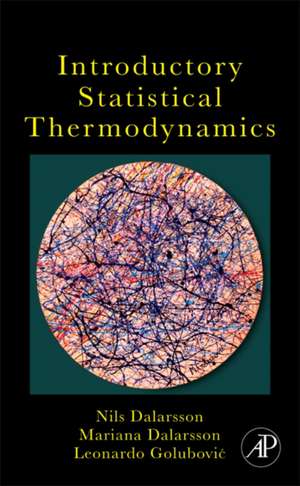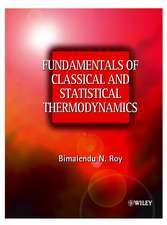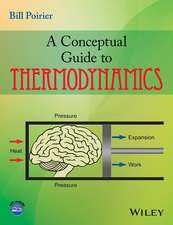Introductory Statistical Thermodynamics
Autor Nils Dalarsson, Mariana Dalarsson, Leonardo Golubovicen Limba Engleză Hardback – 25 ian 2011
- Beginning chapters place an emphasis on quantum mechanics
- Includes problems with detailed solutions and a number of detailed theoretical derivations at the end of each chapter
- Provides a high level of detail in derivations of all equations and results
Preț: 311.82 lei
Preț vechi: 338.93 lei
-8% Nou
Puncte Express: 468
Preț estimativ în valută:
59.69€ • 64.85$ • 50.17£
59.69€ • 64.85$ • 50.17£
Carte tipărită la comandă
Livrare economică 14-28 aprilie
Preluare comenzi: 021 569.72.76
Specificații
ISBN-13: 9780123849564
ISBN-10: 012384956X
Pagini: 408
Ilustrații: Illustrated
Dimensiuni: 152 x 229 x 25 mm
Greutate: 0.66 kg
Editura: ELSEVIER SCIENCE
ISBN-10: 012384956X
Pagini: 408
Ilustrații: Illustrated
Dimensiuni: 152 x 229 x 25 mm
Greutate: 0.66 kg
Editura: ELSEVIER SCIENCE
Public țintă
Upper-level undergraduates, and graduate students of physics and engineering.Cuprins
Part I QUANTUM DESCRIPTION OF SYSTEMS2 Introduction and Basic Concepts3 Kinetic energy of Translational Motion4 Energy of Vibrations5 Kinetic Energy of RotationsPart II THERMODYNAMICS OF SYSTEMS6 Number of accessible states and Entropy7 Equilibrium States of Systems8 Thermodynamic Variables9 Macroscopic Thermodynamics10 Variable Number of ParticlesPart III IDEAL AND NON-IDEAL GASES11 Ideal Monoatomic Gases12 Ideal Diatomic Gases13 Non-ideal Gases14 Quasi-static Thermodynamic ProcessesPart IV QUANTUM STATISTICAL PHYSICS15 Quantum Distribution Functions16 Electron Gases in Metals17 Photon Gas in Equilibrium18 Other examples of Boson Systems19 Special TopicsApp Physical constants
Recenzii
"The book is intended as a text for an introductory course in statistical thermodynamics for undergraduate students of physical sciences or engineering. Parts of the material may be useful as well for a graduate course. The book is quite detailed in explicit derivations of all equations and results, followed by a number of fully solved problems/exercises that illustrate theoretical concepts discussed throughout the book. An introductory chapter contains some very basic quantum mechanical background. The second chapter contains derivations of basic notions of classical statistical mechanics, together with a discussion of general laws of macroscopic thermodynamics. The third chapter addresses various applications to physically interesting cases of ideal and non-ideal gases. In the last chapter, a discussion of basic concepts of quantum statistical physics (quantum gases) is followed by a brief discussion of relativistic phenomena."--Zentralblatt Math 1225-1
"This book is an excellent introduction to statistical thermodynamics, which covers the fundamental physical concepts used for the macroscopic description of systems with very large number of particles in thermo-dynamic equilibrium. Also the macroscopic concepts used in this book, are shown to be connected to the appropriate microscopic theories. However, in the literature, statistical thermodynamics is frequently introduced purely from macroscopic point of view. But in general the macroscopic description is largely independent on the details of the microscopic models describing the interactions of the particle in various physical systems. So learning the connection between microscopic and macroscopic concept will definitely enhance the understanding of the subject to great extent…I recommend this book as one of the most lucidly written introductory texts on Statistical Thermodynamics."--Contemporary Physics
"This book is an excellent introduction to statistical thermodynamics, which covers the fundamental physical concepts used for the macroscopic description of systems with very large number of particles in thermo-dynamic equilibrium. Also the macroscopic concepts used in this book, are shown to be connected to the appropriate microscopic theories. However, in the literature, statistical thermodynamics is frequently introduced purely from macroscopic point of view. But in general the macroscopic description is largely independent on the details of the microscopic models describing the interactions of the particle in various physical systems. So learning the connection between microscopic and macroscopic concept will definitely enhance the understanding of the subject to great extent…I recommend this book as one of the most lucidly written introductory texts on Statistical Thermodynamics."--Contemporary Physics







